
Shreveport is a city in the U.S. state of Louisiana. It is the third most populous city in Louisiana after New Orleans and Baton Rouge, respectively. The Shreveport–Bossier City metropolitan area, with a population of 393,406 in 2020, is the fourth largest in Louisiana, though 2020 census estimates placed its population at 397,590. The bulk of Shreveport is in Caddo Parish, of which it is the parish seat. It extends along the west bank of the Red River into neighboring Bossier Parish. The United States Census Bureau's 2020 census tabulation for the city's population was 187,593, though the American Community Survey's census estimates determined 189,890 residents.
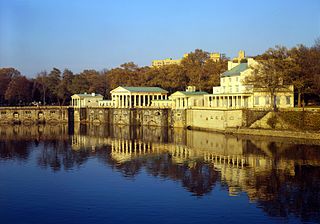
The Fairmount Water Works in Philadelphia, Pennsylvania was Philadelphia's second municipal waterworks. Designed in 1812 by Frederick Graff and built between 1812 and 1872, it operated until 1909, winning praise for its design and becoming a popular tourist attraction. It now houses a restaurant and an interpretive center that explains the waterworks' purpose and local watershed history. It was designated a National Historic Landmark in 1976 for its architecture and its engineering innovations. It was the nation's first water supply to use paddle wheels to move water.
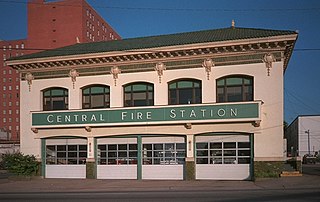
Shreveport, Louisiana, was founded in 1836 by the Shreve Town Company, a development corporation established to start a town at the meeting point of the Red River and the Texas Trail. In this period, a 180-mile (289 km) long natural logjam, the Great Raft, had obstructed passage to shipping. The Red River was cleared and made newly navigable by Captain Henry Miller Shreve of the United States Army Corps of Engineers. Shreve used a specially modified riverboat, the Heliopolis, to remove the logjam. The company and the village of Shreve Town were named in Shreve's honor.
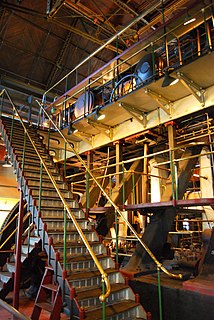
The Leavitt-Riedler Pumping Engine (1894) is a historic steam engine located in the former Chestnut Hill High Service Pumping Station, in Boston, Massachusetts. It has been declared a historic mechanical engineering landmark by the American Society of Mechanical Engineers. The pumping station was decommissioned in the 1970s, and turned into the Metropolitan Waterworks Museum in 2011.

The Bethlehem Waterworks, also known as the Old Waterworks or 1762 Waterworks, is believed to be the oldest pump-powered public water supply in what is now the United States. The pumphouse, which includes original and replica equipment, is located in the Colonial Industrial Quarter of downtown Bethlehem, Pennsylvania, between the Monocacy Creek and Main Street. It was declared a National Historic Civil Engineering Landmark in 1971, an American Water Landmark in 1971, and a National Historic Landmark in 1981. The building is a contributing property to the Historic Moravian Bethlehem Historic District which was designated as a National Historic Landmark District in 2012 and later named to the U.S. Tentative List in 2016 for nomination to the World Heritage List.

Walka Water Works is a heritage-listed 19th-century pumping station at 55 Scobies Lane, Oakhampton Heights, City of Maitland, New South Wales, Australia. Originally built in 1887 to supply water to Newcastle and the lower Hunter Valley, it has since been restored and preserved and is part of Maitland City Council's Walka Recreation and Wildlife Reserve. It was added to the New South Wales State Heritage Register on 2 April 1999.
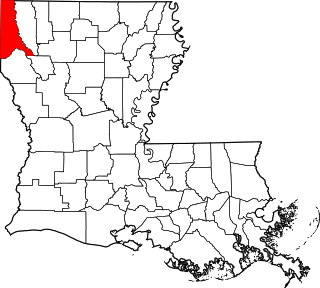
This is a list of the National Register of Historic Places listings in Caddo Parish, Louisiana.
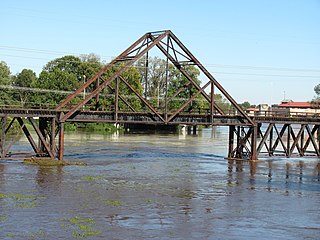
The Kansas City Southern Railroad Bridge , in downtown Shreveport, Louisiana, is an "A" Truss bridge erected in its current location in 1926 and abandoned in the 1980s. Due to its national significance to the progress of American bridge design, and its rarity as one of only two known surviving examples, the structure was designated a National Historic Place in 1995.

Shreveport Municipal Memorial Auditorium is a historic performance and meeting venue at 705 Elvis Presley Boulevard in Shreveport, Louisiana. It is an Art Deco building constructed between 1926 and 1929 during the administration of Mayor Lee Emmett Thomas as a memorial to the servicemen of World War I. In 1991, the auditorium was listed on the National Register of Historic Places and on October 6, 2008, it was designated a National Historic Landmark.
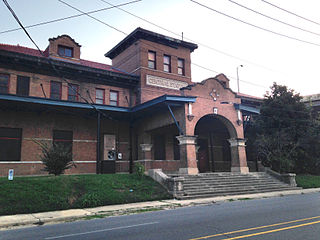
Shreveport Central Station is a historic train station in Shreveport, Louisiana. It was built in 1910 by the Louisiana and Arkansas Railroad, a railroad that was eventually acquired by the Kansas City Southern Railway. By the opening of the 1940s the L&A and the St. Louis Southwestern Railway or 'Cotton Belt' moved its passenger operations from Central Station to Shreveport Union Station.

Cross Bayou is a 38.0-mile-long (61.2 km) river in Texas and Louisiana. It is a tributary of the Red River, part of the Mississippi River watershed.

Manchester's Hydraulic Power system was a public hydraulic power network supplying energy across the city of Manchester via a system of high-pressure water pipes from three pumping stations from 1894 until 1972. The system, which provided a cleaner and more compact alternative to steam engines, was used to power workshop machinery, lifts, cranes and a large number of cotton baling presses in warehouses as it was particularly useful for processes that required intermittent power. It was used to wind Manchester Town Hall clock, pump the organ at Manchester Cathedral and raise the safety curtain at Manchester Opera House in Quay Street. A large number of the lifts and baling presses that used the system had hydraulic packings manufactured by John Talent and Co.Ltd. who had a factory at Ashworth Street, just off the Bury New Rd. close to the Salford boundary.

The Davenport Water Co. Pumping Station No. 2, also known as the Ripley Street Pumping Station No. 2, is located in central Davenport, Iowa, United States. It has been listed on the National Register of Historic Places since 1984. The historic building has subsequently been replaced in 1986 by a smaller plain structure on the same property facing West 14th Street.

1879 Houston Waterworks is a building located in Houston, Texas listed on the National Register of Historic Places.

The City of Beloit Waterworks and Pump Station was built in 1885 in Beloit, Wisconsin just below a hill on top of which sits the Beloit Water Tower. It was added to the National Register of Historic Places in 1990.

The Conrad Rice Mill is an independently owned and operated rice mill located in New Iberia, Louisiana, and produces the Konriko brand of rice varieties. Established in 1912, it is the oldest independently owned rice mill in the United States still in operation.
The following is a timeline of the history of the city of Shreveport, Louisiana, USA.

The Hamilton Waterworks, also known as the Hamilton Waterworks Pumping Station, is a National Historic Site of Canada located in Hamilton, Ontario. It is an industrial water works structure built in the Victorian style, and a rare example of such a structure in Canada to be "architecturally and functionally largely intact". It is currently used to house the Museum of Steam and Technology.

The Waterworks Museum is a museum in the Chestnut Hill Waterworks building, originally a high-service pumping station of the Boston Metropolitan Waterworks. It contains well-preserved mechanical engineering devices in a Richardsonian Romanesque building.

Madison Waterworks, also known as Nichols Station, is a historic building on East Gorham Street between North Franklin and North Hancock in Madison, Wisconsin. The building was built in 1917 as part of an effort to overhaul Madison's municipal water system; in addition to its new pumping station, the city also began supplying its water system from Lake Mendota rather than artesian wells. To maintain the city's water supply during construction, the new pumping station was built around the original. Architects Balch & Lippert designed the building in a functional interpretation of the Prairie School style with mock turrets, a parapet along the roof, and several gables. The city reused elements of the design in many of the later buildings it built for the water system. The building originally included two Allis-Chalmers steam pumping engines, one of which still remained when the station was decommissioned in 1976; according to the Historic American Engineering Record, it is a rare surviving example of a large steam pumping engine.























